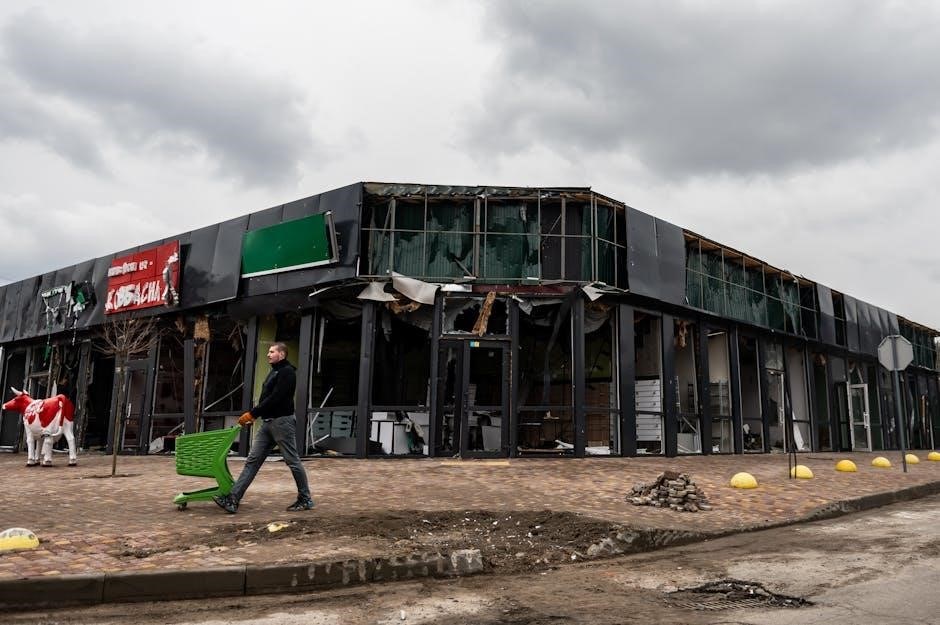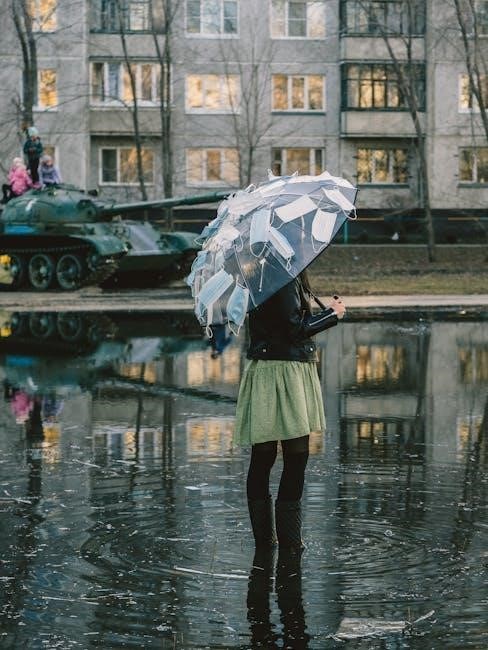Urban warfare presents unique challenges‚ with densely populated areas and narrow streets limiting tank mobility. Despite vulnerabilities to anti-tank weapons‚ tanks remain crucial in urban combat‚ providing firepower and support to infantry. Their effectiveness depends on combined arms operations‚ highlighting the need for strategic coordination and adaptability in such environments.
1.1 The Evolution of Urban Warfare
Urban warfare has evolved significantly over centuries‚ transitioning from sieges of fortified cities to complex battles in densely populated areas. Early urban conflicts often involved traditional siege tactics‚ but modern warfare introduced new challenges. The rise of armored vehicles in World War II marked a turning point‚ as tanks were first deployed in cities like Stalingrad and Berlin. Subsequent conflicts‚ such as Vietnam and Mogadishu‚ highlighted the limitations of tanks in urban environments due to narrow streets and anti-tank weaponry. Today‚ urban warfare emphasizes combined arms operations‚ where tanks‚ infantry‚ and air support must coordinate to navigate the complexities of modern cities and mitigate civilian casualties.

1.2 The Historical Context of Tanks in Urban Combat
Tanks were initially designed for open-field battles‚ but their role in urban combat emerged during World War II‚ particularly in Stalingrad and Berlin. These early deployments revealed both the potential and limitations of tanks in cities. Narrow streets and rubble-strewn terrain hindered mobility‚ while buildings provided cover for anti-tank weapons. Despite these challenges‚ tanks proved essential for breaking through enemy defenses and providing firepower. Post-war conflicts‚ such as Vietnam and Mogadishu‚ further underscored the need for specialized tactics and infantry support. Historical lessons highlight the importance of adapting tank doctrine to urban environments‚ emphasizing coordination with ground forces to overcome the unique obstacles of city warfare.

Historical Case Studies of Tanks in Urban Warfare

Historical conflicts reveal the complexities of urban tank warfare‚ with battles like Stalingrad‚ Hue City‚ and Mogadishu showcasing both the effectiveness and vulnerabilities of tanks in dense environments.
2.1 World War II: Tanks in Stalingrad and Berlin
During World War II‚ the battles of Stalingrad and Berlin starkly demonstrated the challenges and significance of tank warfare in urban environments. In Stalingrad‚ German tanks faced severe limitations due to narrow streets and Soviet tactics like “hugging the enemy‚” which neutralized their advantages. Similarly‚ in Berlin‚ Soviet tanks encountered heavy resistance‚ with anti-tank weapons and improvised traps causing significant losses. These battles highlighted the importance of infantry-tank coordination and the need for specialized urban warfare tactics. The lessons learned from these conflicts shaped future military doctrines‚ emphasizing the necessity of adaptability and combined arms operations in densely populated areas.
2.2 Vietnam War: Tanks in Hue City
The Vietnam War’s Battle of Hue City showcased the critical role of tanks in urban combat despite significant challenges. U.S. Marine tanks provided decisive firepower‚ supporting infantry in house-to-house fighting against entrenched North Vietnamese forces. However‚ narrow streets and alleyways restricted tank mobility‚ making them vulnerable to anti-tank weapons and improvised explosives. The effectiveness of tanks depended heavily on close coordination with infantry‚ who cleared buildings and secured routes. Despite these limitations‚ tanks proved essential in breaking enemy strongpoints and securing key objectives‚ underscoring their value in urban warfare when employed as part of combined arms teams.
2.3 Modern Conflicts: Tanks in Mogadishu and Grozny
The battles of Mogadishu and Grozny exemplify the challenges of modern urban warfare. During the 1993 Battle of Mogadishu‚ U.S. forces faced intense urban combat‚ where tanks were vulnerable to rocket-propelled grenades and improvised explosives. Similarly‚ in Grozny during the Chechen Wars‚ Russian tanks suffered heavy losses due to poor coordination with infantry and guerrilla tactics. Both conflicts highlighted the limitations of tanks in dense urban environments and the critical need for combined arms operations. These battles underscored the importance of infantry support‚ adaptable tactics‚ and the ongoing evolution of tank doctrine to address modern urban warfare challenges.
Challenges of Employing Tanks in Urban Environments
Urban environments pose significant challenges for tanks‚ including narrow streets‚ anti-tank weapons‚ and civilian presence. These factors increase vulnerability and complicate military operations.
3.1 Narrow Streets and Urban Terrain Limitations
Urban environments pose significant challenges for tank operations due to narrow streets‚ dense buildings‚ and complex terrain. Tanks‚ designed for open-field maneuverability‚ struggle in confined spaces‚ limiting their effectiveness. The layout of cities often forces tanks into predictable routes‚ making them vulnerable to ambushes and anti-tank weapons. Additionally‚ tall buildings and alleyways obstruct lines of sight‚ reducing the effectiveness of tank weaponry. The physical constraints of urban terrain also increase the risk of collateral damage‚ complicating military operations. These factors highlight the need for careful planning and infantry support to mitigate the limitations of tank deployment in urban warfare scenarios.

3.2 Vulnerability to Anti-Tank Weapons

Tanks in urban environments are highly vulnerable to anti-tank weapons‚ such as rocket-propelled grenades and improvised explosive devices. The proximity of buildings and narrow streets allows insurgents and enemy forces to exploit weak points‚ such as the sides and rear of tanks. Unlike open terrain‚ urban settings negate the advantages of tank speed and long-range firepower‚ making them easy targets. Additionally‚ the cost-effectiveness of anti-tank weapons compared to tanks themselves makes them a significant threat. Historical conflicts‚ such as those in Grozny and Mogadishu‚ highlight the risks of deploying tanks without adequate infantry support‚ emphasizing the need for combined arms tactics to mitigate these vulnerabilities in urban warfare.
3.3 Civilian Presence and Collateral Damage Concerns

Urban warfare inherently involves significant civilian presence‚ raising concerns about collateral damage. Tanks‚ despite their effectiveness‚ often cause unintended harm to non-combatants and infrastructure. The density of urban populations complicates military operations‚ as minimizing civilian casualties is a priority. Rules of engagement for forces like the U.S. military are stringent‚ unlike insurgents who may disregard civilian lives‚ as seen in Hue City. The destruction caused by tanks can exacerbate humanitarian crises‚ making post-conflict reconstruction challenging. Balancing military objectives with civilian safety remains a critical challenge in urban tank operations‚ necessitating precise tactics to mitigate unintended consequences. This dilemma is central to modern urban warfare strategies.

Adaptation of Tank Doctrine for Urban Warfare
Modern tank doctrine emphasizes combined arms operations‚ integrating infantry and armored units for urban success. Technological advancements and tactical innovations enhance tank effectiveness in densely populated environments.
4.1 Combined Arms Operations: Infantry and Tank Coordination
Combined arms operations are essential for effective urban warfare‚ requiring seamless coordination between infantry and tanks. Infantry provides critical support by clearing buildings‚ securing key routes‚ and neutralizing anti-tank threats‚ while tanks deliver heavy firepower and mobility. This synergy overcomes the limitations of tanks in urban environments‚ such as narrow streets and ambush risks. Technological advancements‚ like improved communication systems and specialized urban tank designs‚ enhance this coordination. Historical lessons from battles like Hue City and Mogadishu emphasize the importance of integrated tactics‚ ensuring that infantry and tanks operate as a cohesive unit to achieve operational success in densely populated areas.
4.2 Technological Advancements in Urban Tank Design
Technological advancements have been crucial in optimizing tanks for urban warfare. Modern designs incorporate reactive armor to counter anti-tank weapons‚ while specialized tracks enhance mobility on uneven terrain. Thermal imaging and advanced fire control systems improve target acquisition in cluttered environments. These innovations address urban-specific challenges‚ such as narrow streets and ambush risks. Additionally‚ tanks now feature reinforced armor to withstand improvised explosive devices and rocket-propelled grenades. Such advancements ensure tanks remain effective in urban combat while minimizing collateral damage. These improvements reflect lessons learned from historical conflicts‚ emphasizing the need for adaptable and resilient tank designs in densely populated areas.
4.3 Lessons Learned from Historical Urban Battles
Historical urban battles have provided critical insights into the challenges and opportunities of employing tanks in cities. Battles like Stalingrad‚ Berlin‚ Hue City‚ Mogadishu‚ and Grozny highlight the importance of infantry support‚ as tanks alone are often insufficient in urban environments. These conflicts also underscore the vulnerability of tanks to anti-tank weapons and improvised explosives in narrow streets. Additionally‚ the presence of civilians and the need to minimize collateral damage have shaped modern doctrines. Lessons from these battles emphasize the need for combined arms operations‚ adaptive tactics‚ and the integration of technological advancements to enhance tank effectiveness in urban warfare. These experiences continue to influence military strategies today.
The Future of Tanks in Urban Warfare
The future of tanks in urban warfare lies in technological advancements‚ strategic innovations‚ and enhanced coordination with infantry‚ ensuring their relevance and effectiveness in modern conflicts.

5.1 Modernization of Tank Technology for Urban Environments
Modernizing tank technology is critical for urban warfare‚ focusing on enhancing mobility‚ protection‚ and precision. Advances include modular armor‚ reactive armor‚ and active protection systems to counter anti-tank threats.
Urban-specific designs prioritize compact profiles and quieter engines to navigate narrow streets. Real-time data systems and AI-driven targeting improve situational awareness‚ reducing collateral damage.
These innovations ensure tanks remain viable in dense urban environments‚ addressing historical vulnerabilities while maintaining lethal capabilities. Ongoing research aims to optimize tanks for future urban conflicts‚ ensuring adaptability and effectiveness.
5.2 Strategic and Tactical Innovations in Urban Tank Deployment
Modern urban warfare demands strategic and tactical innovations in tank deployment‚ emphasizing precision and adaptability. Advanced targeting systems and network-centric capabilities enhance situational awareness‚ enabling tanks to engage targets effectively while minimizing collateral damage.
Case studies from Mogadishu to Iraq reveal the importance of combined arms operations‚ where tanks operate in tandem with infantry and drones for real-time intelligence.

Innovative tactics include the use of suppressive fire‚ rapid repositioning‚ and modular armor to counter urban threats. These strategies ensure tanks remain relevant in densely populated environments‚ balancing firepower with operational agility.
